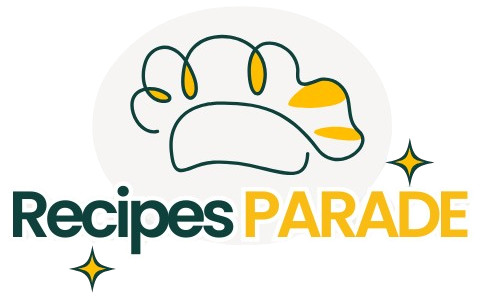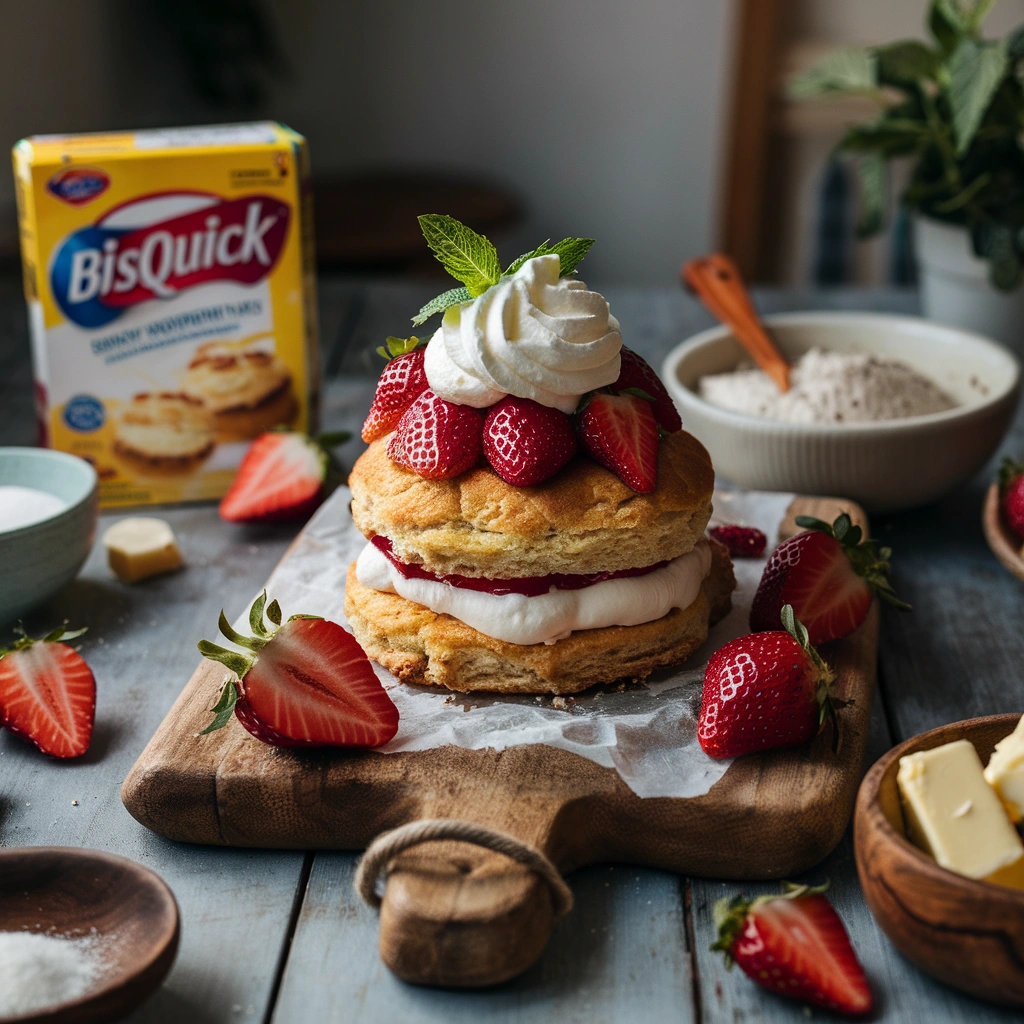Table of Contents
Bisquick shortcake is a beloved dessert that’s quick to make, versatile, and loved by many. Whether it’s topped with fresh strawberries or whipped cream, this simple yet delicious treat is a go-to for home bakers and those looking for a fast dessert fix. But what exactly makes a Bisquick shortcake different from other baked goods, like biscuits or traditional cakes? Additionally, if you’re out of Bisquick or simply want to explore other options, there are many substitutes available.
In this article, we’ll explore the differences between Bisquick shortcake and other similar baked goods, such as biscuits and cakes. We’ll also discuss whether Bisquick is the same as pancake mix and provide you with some tasty substitutes if you’re in need of a replacement.
What is Bisquick Shortcake?
Definition and Ingredients
Bisquick is a pre-made mix that’s often used in a variety of recipes, from pancakes to dumplings, and even in shortcakes. The beauty of Bisquick is that it simplifies baking by combining flour, baking powder, salt, and fat into one easy-to-use product. When it comes to Bisquick shortcake, the mix is used to create a fluffy, soft base that perfectly complements sweet fruits like strawberries or peaches.
A typical Bisquick shortcake recipe involves mixing Bisquick with sugar, milk, and butter, resulting in a simple dough that is either spooned onto a baking sheet or rolled out and cut into rounds. After baking, these shortcakes are often topped with whipped cream or fruit for an indulgent dessert.
Common Ingredients in a Bisquick Shortcake Recipe
- Bisquick (or an alternative)
- Milk
- Butter
- Sugar
- Eggs (optional for extra richness)
- Baking powder (if making your own version)
- Whipped cream or fruit (for topping)
Key Differences Between Shortcake and Biscuits
Texture and Flavor
The texture of Bisquick shortcake differs from that of traditional biscuits. Shortcakes, made with a mixture like Bisquick, tend to be fluffier and lighter in texture. They melt in your mouth, offering a slightly sweet, biscuit-like consistency that contrasts nicely with the tartness of berries. Biscuits, on the other hand, are more crumbly and have a savory flavor, often due to the higher amount of butter and lack of sweetness in their dough.
Shortcakes also tend to have a softer, more cake-like texture, while biscuits are denser with a more crumbly, flaky consistency. This difference in texture makes shortcakes ideal for soaking up juicy fruit and cream, whereas biscuits are better for pairing with savory dishes like gravy or soup.
Ingredients and Preparation Methods
The ingredients in shortcake differ from those in biscuits, primarily because shortcakes often contain a touch of sugar to make them sweet. While both recipes use a form of leavening agent like baking powder, biscuits sometimes incorporate baking soda for added rise. The key to the lightness of shortcake is its careful preparation. Over-mixing biscuit dough can result in a denser texture, while shortcake dough requires only minimal handling to keep it light and tender.
For biscuits, a cold fat (such as butter) is often “cut” into the flour to create flakiness. Shortcake dough, however, doesn’t need to be as flaky, which is why it uses a different mixing method that results in a softer, more cohesive dough.
Usage in Desserts
Shortcakes are most commonly used in desserts, where their light, airy texture complements fresh fruit, like strawberries or peaches, and is topped with a generous helping of whipped cream. You might also find shortcake used as a base for trifles or other layered desserts.
In contrast, biscuits, while they can sometimes be sweet, are not typically featured in dessert contexts. They are generally served with savory dishes, such as fried chicken, sausages, or gravy, and are not traditionally paired with fruit and cream.
Is Bisquick the Same as Pancake Mix?
Ingredients and Composition
At first glance, Bisquick and pancake mix might seem interchangeable. Both contain flour, baking powder, salt, and fat. However, there is a key difference: Bisquick typically includes a combination of fats, such as shortening or vegetable oil, and has a higher proportion of leavening agents to create a fluffier, lighter texture. Pancake mix, on the other hand, is designed primarily to make pancakes and has a slightly different ratio of ingredients that give pancakes a smooth, consistent texture without the need for extra fat.
Intended Uses
While both Bisquick and pancake mix are great for quick baking, their uses can differ. Bisquick is more versatile and can be used for pancakes, waffles, biscuits, dumplings, and even shortcakes. It’s an all-purpose baking mix, designed to simplify the process of making a variety of baked goods. Pancake mix, however, is specifically designed for pancakes (and sometimes waffles), meaning it lacks the versatility of Bisquick. If you’re in a pinch and need to make something beyond pancakes, Bisquick is a better option.
Taste and Texture Differences
When used in different recipes, the taste and texture of Bisquick and pancake mix can differ slightly. Bisquick tends to have a richer, more buttery flavor, which makes it an ideal choice for biscuits or shortcakes, where that richness enhances the overall flavor. Pancake mix is milder, and while it works perfectly for pancakes, it might not deliver the same depth of flavor in recipes like shortcakes.
What is the Difference Between a Cake and a Shortcake?
Structure and Texture
A key difference between cakes and shortcakes lies in their structure and texture. Cakes tend to be more airy and light, often made with whipped eggs or beaten butter, and typically have a delicate, soft crumb. In comparison, shortcakes are more dense and crumbly, thanks to the way the dough is mixed, resulting in a more biscuit-like structure. Shortcakes have a slight sweetness, but they are often less sugary than cakes, which are usually sweeter and more moist.
Preparation Techniques
Cakes are typically made by creaming butter and sugar, followed by adding dry ingredients and liquids. Shortcakes, on the other hand, are mixed by gently combining dry ingredients with wet ingredients until just incorporated. Overworking shortcake dough can result in a tough texture, which is why minimal handling is key.
Additionally, shortcakes are often baked in individual rounds or spooned onto a baking sheet, whereas cakes are typically poured into pans and baked in a larger form.
Serving and Pairing
Cakes are commonly served as the centerpiece of a dessert table, often layered with frosting or icing, and paired with fruits or chocolate. Shortcakes, however, are typically served in individual portions, often topped with fresh fruit (like strawberries or raspberries) and a dollop of whipped cream. The pairing for shortcakes is usually fruit-based, while cakes can be paired with a variety of frostings or toppings.
What Can Be Used Instead of Bisquick?
Homemade Bisquick Alternatives
If you don’t have Bisquick on hand, you can easily make your own version at home. The ingredients are simple and likely already in your pantry. To make a homemade Bisquick substitute, combine the following:
- 1 cup all-purpose flour
- 1 1/2 teaspoons baking powder
- 1/4 teaspoon salt
- 1 tablespoon vegetable oil or shortening
Mix these ingredients together, and you’ve got yourself a DIY Bisquick mix that can be used in recipes just like the store-bought version.
Store-bought Substitutes
If you’re not keen on making your own mix, several other store-bought alternatives can be used. Brands like Jiffy, Krusteaz, or even a basic all-purpose flour mix can work in place of Bisquick for most recipes, including shortcakes and biscuits. Simply follow the instructions for the mix you’re using, keeping in mind that you may need to adjust for the level of sweetness or richness in the recipe.
Adjustments for Gluten-Free Options
For those who are gluten-sensitive, there are gluten-free alternatives to Bisquick, such as Bob’s Red Mill or King Arthur Flour’s gluten-free mixes. These products are specially formulated to mimic the texture and lightness of Bisquick without using wheat flour. For those making their own gluten-free Bisquick alternative, a mix of rice flour, cornstarch, and a gluten-free leavening agent should do the trick.
Conclusion
In summary, understanding the differences between Bisquick shortcake, biscuits, cakes, and pancake mixes can help you make the most of your baking experience. Whether you’re looking to create a delicious shortcake or need to substitute Bisquick with another product, knowing the distinctions ensures that your dessert turns out perfectly every time. So, get creative in the kitchen, try out different substitutes, and enjoy the versatility of shortcakes in your baking adventures.
Hey ! Leave a comment
We’d love to hear about your experiences with Bisquick shortcake and any delicious twists you’ve added! Have you tried using any of the substitutes we mentioned? Share your thoughts and results in the comments below – we’d love to see what you’ve baked!
FAQ
Why is it called shortcake?
Shortcake gets its name from the word “short,” which refers to the crumbly texture of the cake. The term “short” comes from the use of shortening or fat in the recipe, which makes the cake tender and flaky.
What flavour is shortcake?
Shortcake has a mild, slightly sweet flavor, often with a buttery undertone. It’s typically not overly flavored on its own, serving as a base for fruits like strawberries or other toppings.
What can I replace Bisquick with?
You can replace Bisquick with a homemade mix of flour, baking powder, salt, and shortening. A typical substitution is 1 cup of all-purpose flour, 1 1/2 teaspoons of baking powder, and 1/4 cup of shortening or butter.
Is Bisquick just flour and baking powder?
Bisquick is more than just flour and baking powder. It’s a pre-mixed combination of flour, baking powder, salt, and fat (often vegetable oil or shortening), making it convenient for quick baking.
What is better than Bisquick?
Some people prefer homemade biscuit or pancake mixes because they can control the ingredients, avoid additives, and adjust the recipe to their liking. For instance, mixing flour, baking powder, salt, and a fat of choice can often produce a fresher, more customized result.
Is shortcake the same as shortbread?
No, shortcake and shortbread are different. Shortcake is a soft, crumbly cake often used as a base for fruit desserts, while shortbread is a dense, buttery biscuit that’s typically sweet and used on its own or as a cookie.
Why is strawberry shortcake so good?
Strawberry shortcake is loved for its balance of flavors and textures. The sweet, juicy strawberries pair perfectly with the light, buttery shortcake, and whipped cream adds a creamy contrast, creating a delightful combination.
What is a cake without frosting called?
A cake without frosting is often referred to as a “naked cake.” It’s a simpler, less decorated version of a cake, where the layers are exposed and the cake’s natural texture and flavor are the focus.
Can I use pancake mix instead of Bisquick?
Yes, pancake mix can be used instead of Bisquick in most recipes. They both contain flour, baking powder, and other ingredients, although pancake mix may be slightly sweeter. Adjustments can be made to account for this if needed.
Do you add water or milk to Bisquick?
When using Bisquick for pancakes or biscuits, milk is typically added to create a smoother batter or dough. However, some recipes may call for water depending on the desired consistency or type of dish.
Is Bisquick just self rising flour?
No, Bisquick is not the same as self-rising flour. While both contain flour and baking powder, Bisquick also includes fat (like shortening) and salt, making it more convenient for quick recipes without needing to add extra fat or seasoning.

